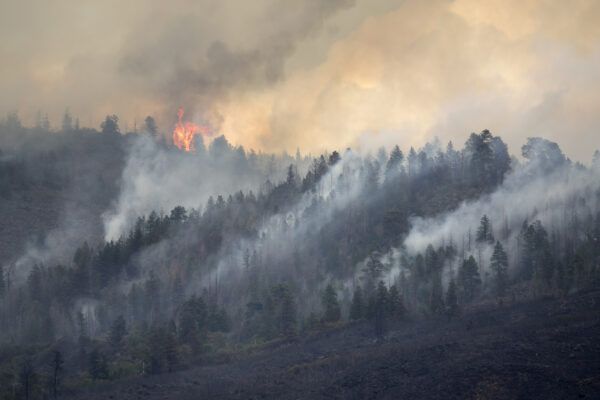Wildfires continue to frequent news headlines around the world. This spike in wildfires is a product of the climate crisis and land use changes.
According to the EU Commission, both the 2022 and 2023 wildfire seasons were in the five worst on record. In 2024 alone, global wildfires and vegetation fires generated around 1,940 megatonnes of carbon monoxide (Copernicus Atmosphere Monitoring Service).
In the same year, wildfires in Chile claimed the lives of 137 people and caused an estimated $4.39 billion in damage. The Canadian wildfires released more carbon in five months than Russia or Japan emitted from fossil fuels in all of 2022. And earlier this year saw fires in Los Angeles become some of the most destructive and costly in US history, despite occurring outside of the usual wildfire season.
The relationship between air pollution, climate change and wildfires is a vicious cycle that threatens people, animals and planet. Burning trees releases carbon and particulate matter, causing air quality to plummet. Understanding the interconnectedness of these issues is key to unlocking an effective, joined up approach.
Understanding the connection
Air pollution, wildfires and climate change are closely linked. Human activities, such as burning fossil fuels, transportation and industrial processes, release greenhouse gases and black carbon emissions, which fuel climate change. These pollutants trap heat in the atmosphere, causing the earth’s temperature to rise and weather patterns to become more erratic. This in turn increases the likelihood of wildfires, particularly by exacerbating drought conditions which make forests more vulnerable to fire.
Black carbon is particularly harmful to the climate and human health. Wildfires are one of the largest sources of black carbon, a super pollutant that intensifies heatwaves, alters weather patterns, and accelerates the melting of ice and snow, further perpetuating the cycle of climate change and extreme wildfires. East Siberian wildfires accounted for elevated black carbon levels in the Arctic in 2019-2021. Black carbon from the Amazonian fires was estimated to increase glacier melting by 3–4%.
So more frequent and intense wildfires are a by-product of climate change, but they also cause and exacerbate more fires – perpetuating a vicious cycle.
Wildfires are also bad for public health. They release a range of pollutants into the atmosphere, including black carbon, carbon monoxide, nitrogen oxides and particulate matter. These pollutants can combine with existing air pollution, further increasing smoke’s harmful effects on human health and the environment.
Many of the solutions to climate change and air pollution are the same. Siloed efforts to respond to this escalating global crisis fall short by ignoring how interconnected these issues are.
Breaking the cycle and building resilience
While the global media is currently highlighting the devastation of the Los Angeles fires, recent years have seen crippling blazes across multiple continents. The Australian wildfires during 2019-20 have been estimated to produce carbon emissions that are 1.6 times greater than the country’s total emissions for that year. Other examples include fires near the Canadian arctic which spewed toxic smoke down the US eastern seaboard for weeks. Bolivia experienced the most fires ever recorded in a season and Greece suffered the largest single fire in Europe since the 1980s.
Given the severity of the impacts of the vicious cycle between air pollution, climate change and wildfires, governments need to take action to break it. Rather than solely concentrating efforts on putting out multiple fires, governments should take note of the interconnectedness between climate change, air pollution and wildfires and take a joined up approach.
Super pollutants, including black carbon released by fires, have collectively driven half of global warming to date and contribute to the 8 million premature deaths from air pollution every year. The thick smoke from wildfires underscores the severe threat to life, health, and the environment from airborne particles.
Policymakers now have a critical opportunity to raise their ambition. By addressing super pollutants, they can offer a vital solution to combat both the climate crisis and the pollution that harms us all.
Jane Burston, CEO of Clean Air Fund
Attention should be directed to interventions with long-standing, sustainable impact, with a shift from a reactionary approach to prevention. For instance, experts have put forward the ‘Fire Ready Formula’, with two-thirds of spending devoted to planning, prevention, preparedness and recovery, with one third left for response. Countries also established the ‘REDD+’ framework to protect forests as part of the Paris Agreement. But governments tend to overlook some of the best opportunities to tackle climate change because they overlook substantial economic, healthcare and other benefits these policies also offer by reducing air pollution.
Measures to reduce black carbon are an effective way of preventing wildfires while improving public health and avoiding climate tipping points. Check out the Case for Action on Black Carbon for effective and practical solutions to reduce black carbon emissions immediately, including controlling wildfires through community engagement in forest management. You can also learn more about the benefits of a joined up approach for tackling air pollution and climate change together.

